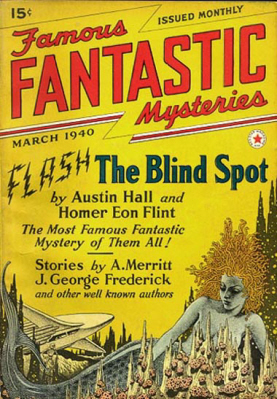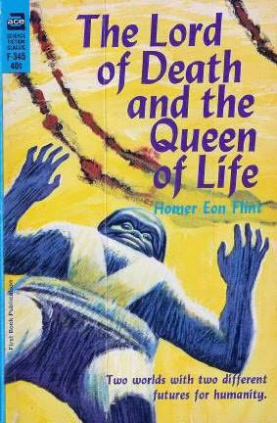SF writers as (or around) criminals: Homer Eon Flint
 Last night at dinner we were discussing (as one does) Homer Eon Flint.
Last night at dinner we were discussing (as one does) Homer Eon Flint.
Since my guests were working on ideas for the 2011 Potlatch convention, we can be forgiven this. Flint was a local author, having grown up in San Jose, and there was talk of doing a panel on him.
I had not known that Flint was working in a shoe repair shop in SJ, or that he was killed in a car crash (perhaps after stealing it from a local gangster, perhaps instead murdered by that local gangster).
It’s covered on his Wikipedia page, and in the article by his granddaughter Vella Munn, “Homer Eon Flint: A Legacy,” available on the Strange Horizons site.
Munn’s piece talks with great respect of the work of one Mike Ashley in ferreting out facts without disturbing the family’s peace. Munn mentions that there were other writers in the area, with whom Flint (actually, Flindt) used to hang out when he lived here in the teens and early 20’s.
Forry Ackerman talks about Austin Hall meeting Flint in his shoe shop, in his introduction to The Blind Spot, the 1921 novel the two wrote together.
The 1922 History of Santa Clara County mentioning him is online at the Internet Archive.
On page 244 we find:
“The Plotwrights”
On June 8, 1921, the Plotwrights, an association of county fiction writers, was organized in San Jose. The following officers were elected: Homer Eon Flindt, president; Oscar L. Oliver, secretary; Eugene T. Sawyer, treasurer. The objects are sociability, the discussion of the technique of the salable manuscript, the giving of entertainments, the boosting of the beautiful valley of Santa Clara, and the reception and entertainment of visiting authors. The membership consists of the following writers: H. E. Flint, Austin Hall, J. B. Frisbie, James Hanson, Ray Hardin, Ray Hicks, A. Jamison Arroll, E. T. Sawyer.
(n.b. Eugene Taylor Sawyer was the author of this history.)
 Pages 1636-9 (the two middle ones are a photo of someone else) give a good bit of biography of Flint.
Pages 1636-9 (the two middle ones are a photo of someone else) give a good bit of biography of Flint.
This same volume discusses the Fellom family, and on page 292 mentions “James Fellom, the popular novelist” and pulp writer, whom I have mentioned in the past. Fellom’s writing career is discussed in detail on pages 496-9 (again, a photo of someone else in the middle), with mention of his work in the Munsey magazines.
Taylor clearly knew Fellom, even though Fellom wasn’t listed as a member of the writing group.
As for Taylor, he claims to have been an inspiration for Fellom’s writing career, thusly:
“[Fellom] had been a faithful reader of the ‘Nick Carter’ stories by E. T. Sawyer, the historian of this history of Santa Clara County, and the hankering after writing was in his very soul.”
I’m puzzled why Sawyer’s book leaves out all mention of Austin Hall except in conjunction with Flint and the writers’ group; but that’s a tale for another bit of research.
Michael Ward’s website featuring vintage magazine cover and advertising art from the Golden Age of American Illustration is at MagazineArt.org.